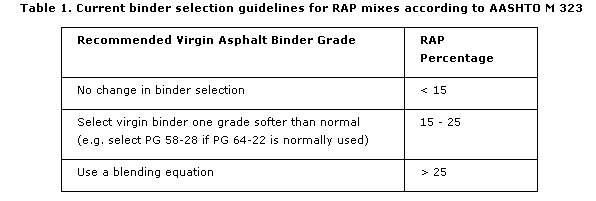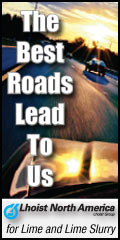| Wednesday, October 31, 2012 | ||
 |
 |
 |
| Past Issues | www.texasasphalt.org | Printer-Friendly | Subscribe | Advertise |
NCAT: Selecting Virgin Binders for RAP Mixes Based on Regional RAP Binder Properties
Contractors and agencies are gaining confidence with the use of higher RAP contents. Field performance studies, including studies that compared long-term performance of overlays with virgin and 30 percent RAP mixes as well as test sections on the NCAT Pavement Test Track with up to 50 percent RAP, have shown that higher RAP content mixes can perform well if they meet standard mix design and quality assurance criteria. Contractors are learning how to manage RAP to minimize dust content, contamination and variability within their stockpiles. Across the US, average RAP contents continue to increase.
One hurdle that sometimes limits the use of higher RAP contents is the selection of the binder grade for the virgin asphalt. For years, conventional wisdom has been to use a softer grade of virgin binder to blend with the aged RAP binder so that the combined binder would have appropriate properties for the climate and traffic conditions. Currently, AASHTO M 323 recommends changing the binder grade at RAP contents greater than 15 percent, as shown in Table 1.
Table 1. Current binder selection guidelines for RAP mixes according to AASHTO M 323
 As seen in Table 1, it is necessary to use a blending equation to estimate the grade of the blended RAP and virgin binders when RAP contents exceed 25 percent by weight of aggregate. Blending equations require determining the critical temperatures of the recovered RAP binder, which involves binder extraction and recovery, an expensive and time-consuming process using potentially hazardous chemicals. Most contractors do not have the equipment necessary to perform these tests, and some highway agencies are hesitant to specify percentages of RAP that require this extra testing.
A new variation of this approach for selecting the virgin binder grade for high RAP content mixes now being reviewed by FHWA's Mix Expert Task Group (ETG) is to determine the properties of RAP binders on a regional basis. In this method, an evaluation is performed on numerous RAP stockpiles within a region/state. The draft procedure is summarized as follows:
 Where:
RBR = RAP Binder Ratio - the ratio of the RAP binder divided by the mixture's total binder content. The mixture's total binder content is an unknown prior to mix design but can be estimated based on historical data for the aggregate types and nominal maximum aggregate sizes.
Tcrit (need) = low critical temperature needed for the climate and pavement layer based on LTPP Bind version 3.1.
Tcrit (virgin) = average low critical temperature of the virgin asphalt binder plus two standard deviations.
Tcrit (RAP Binder) = average low critical temperature of the RAP binders plus two standard deviations.
This approach is based on the premise that the low temperature properties should control the amount of RAP that can be used with a particular virgin binder.
A few states are using statewide RAP binder evaluations to revise RAP specifications. Indiana tested 33 RAP stockpiles across the state and found the average RAP binder to be PG 90-11. Virgin binders, both PG 64-22 and PG 58-28, were also tested. Using the critical low temperatures and the blending equation found in section X1.4 of AASHTO M 323, maximum allowable RAP percentages were calculated to be approximately 23 percent for -22 virgin binders and 38 percent for -28 binders. Based on these calculations, the recommended new specification is no change in binder grade (PG 64-22) for less than 25 percent RAP, and one grade lower (PG 58-28) for 25 to 40 percent RAP.
A similar study in Florida involved testing a total of 21 RAP stockpiles throughout the state's seven districts. The results of the study were used to validate Florida's proposed limits, which include no change in binder grade (PG 67-22) for less than 15 percent RAP, PG 58-22 for 16 to 30 percent RAP, and PG 52-28 for more than 30 percent RAP.
An analysis of 36 RAP stockpiles across Alabama indicates that a maximum 35 percent RAP could be used with PG 67-22 binder and 33 percent RAP with PG 76-22, based on critical low temperatures. This represents 96 percent reliability that a target climate grade of -16°C will be met. Current Alabama specifications allow a maximum of 20 percent RAP for surface mixes and 25 percent for underlying layers. ALDOT also considers contractor-proposed mix designs with up to 35 percent recycled content for binder and base layers using PG 67-22; such mixes require additional testing, including binder extraction and recovery.
In Wisconsin, samples from six RAP stockpiles and six fractionated RAP (FRAP) stockpiles were characterized. The stockpiles were evenly divided between northern and southern areas of the state. The continuous binder grading properties were similar for all of the RAP stockpiles tested, with an average RAP binder grade of PG 82.8-21.8. A reliability analysis was conducted to evaluate Wisconsin's current binder replacement criteria, and revisions were recommended in order to improve the reliability of meeting design low-temperature grades. As a result, a decrease in the percentage of allowable RAP binder was suggested for surface courses (from 25 to 20 percent), while an increase was recommended for underlying layers (from 40 to 45 percent RAP binder replacement).
|
Asphalt: Smooth | Durable | Quiet | Safe





